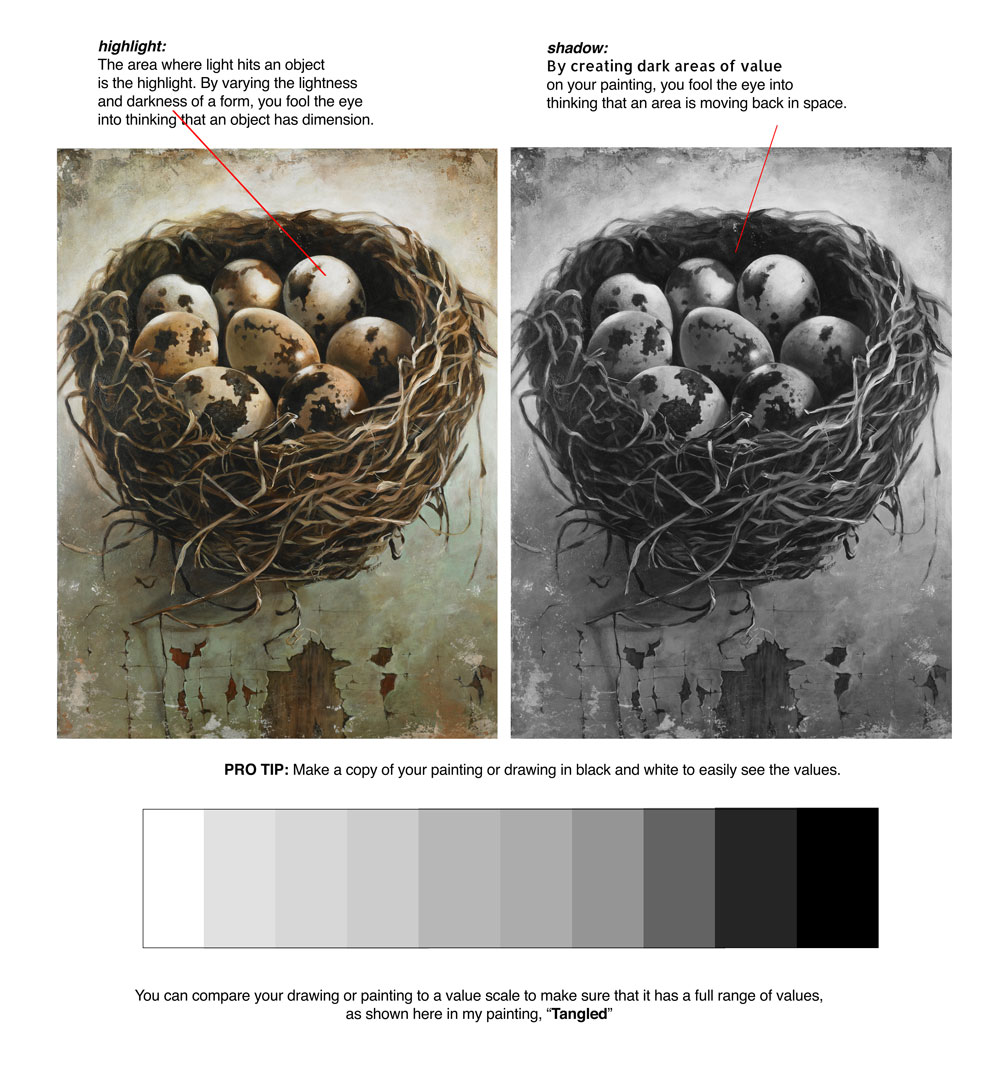If you have ever tried to draw or paint something and make it look like it is “real”, you’ve no doubt attempted to use “values” (whether you realized it or not).
The term “value”, when used in art, is used to describe the difference in lightness or darkness of a color. Artists use light and dark values to create dimension or a focal point within a painting or drawing.
Understanding and controlling the values in your artwork allows you to do two things:
- + GUIDE THE VIEWER’S FOCUS The human eye is immediately drawn to a light element against a dark element. So, by understanding and using values strategically, you can guide the viewer’s eye to a chosen focal point within your composition.
- + GIVE YOUR ARTWORK A 3 DIMENSIONAL APPEARANCE Values are also used to create the illusion of depth and volume, which gives the objects in your artwork the illusion of having dimension.
YOU CAN IMPROVE YOUR DRAWING AND PAINTING SKILLS IMMEDIATELY BY USING VALUES
Artists use lights and darks, or “values” to create the illusion of light and shadow in their work. Highlights appear where light hits an object. The area that turns away from the light source is the shadow area. By recreating these lights and darks with pencil, pen, or paint, an artist mimics what happens in real life and fools the eye into thinking that there are three dimensions to what he has painted, which is actually only two dimensional (on a flat surface).
[clickToTweet tweet=”If you learn to use value in your artwork, you’ll see improvement in your artwork IMMEDIATELY! ” quote=”If you learn to use value correctly in your drawings and paintings, you will begin to see improvement in your artwork IMMEDIATELY! Seriously…you will be amazed!!”]

Artwork that shows full ranges of value are typically successful. A “full range of value” means that there are a variety of light values and dark values in the piece. To be sure that you have a full range of value in your artwork, it’s extremely helpful to create a value scale and compare it to your work.
And BONUS! I’ve created a worksheet that you can download and use to practice on right here.
Once you create your value scale, you can use it to compare the values of your drawing or painting to make sure that you have a range of values displayed in each piece you create. I’ve included simple instructions on how to use your worksheets.
I hope you have found this helpful! Understanding values allow you to see like an artist, which will, in turn, make your drawings and paintings much more successful, relaxing, and fun to create. So, go ahead and print out your values worksheet and start improving your painting and drawing skills today.
TERMS YOU SHOULD KNOW
+ Value– the lightness or darkness of a color
+ Light source– the place where light originates such as the sun, a window, or a lamp
+ Value scale– a guide to creating a range of value, good pieces of art have a full range of value
+ Tint– lighter shade of a color
+ Highlight – Area where light is reflected off of an object
+ Shadow– area obscured from light on an object

Bonnie, this was very well written. I enjoyed your article.
So glad you enjoyed it, Ellie! Thanks so much:)
Thank you, Ellie! So glad you enjoyed it:)